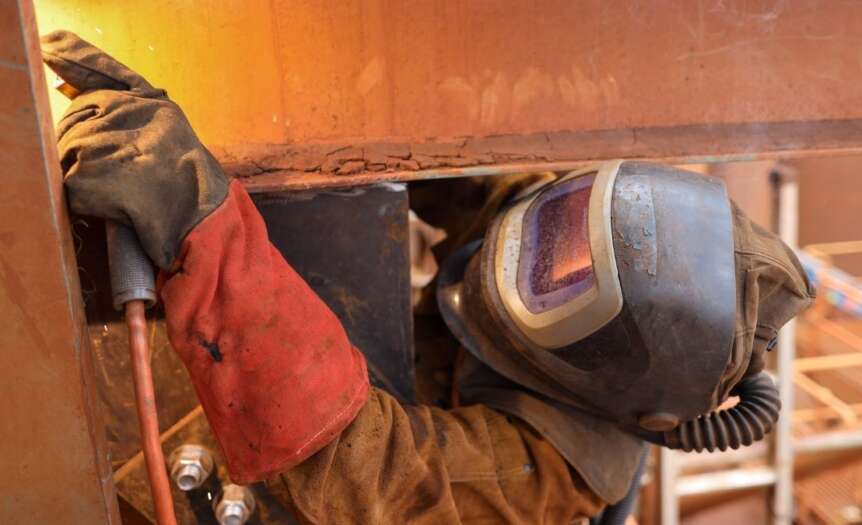Working with metal and the heavy machinery necessary to cut, shape, and weld pieces is an extremely dangerous occupation. Workers clock in facing these hazards every day, and it’s essential for them to come in knowing the various dangers of working with metal and how to protect themselves. Monitor your employees and ensure they follow adequate safety procedures; if not, they run the risk of endangering themselves and others.
Chemical Fumes
When a fabricator joins two pieces of metal together through welding, the process creates a gas that rises from the welding area. Inhaling these fumes comes with several debilitating symptoms, some of which include:
- Nausea
- Eye, nose, and throat irritation
- Lung and kidney damage
- Stomach ulcers
Welding is among the most common practices in a fabrication shop, making it critical to know how to eliminate the threat of inhaling fumes. Among the most reliable safety precautions is the use of a fume extractor, a vacuum arm that sucks the hazardous fumes away from employees. Be aware of how you can negate welding fumes and safeguard your workers.
Airborne Dust
Cutting and shaving down metal sheets creates a cloud of metal shavings; these airborne particulates, like fumes, can enter the body and cause serious illness. Long-term exposure to this kind of particulate matter will result in life-long respiratory illnesses, damaging the lungs and making it difficult for employees to breathe.
For these situations, using a downdraft table is a common solution to eliminate airborne dust. Simultaneously implementing respirators will also significantly reduce the chances of inhaling metal dust; just make sure to maintain the equipment. Before and after every session, have employees inspect the suction of the downdraft table and check the respirator’s filter.
Cuts To the Skin
Cutting and bending metal can easily create rough ridges and burrs, sharp edges that will slice the skin open. Handling metal sheets is a necessary part of the job, and the potential for a burr is always present; these metal ridges can cut deep into the hand, requiring immediate medical attention.
During every phase of the metalworking process, employees must wear protective, cut-resistant gloves to prevent cuts. Even if they only handle the metal sheet for a moment, that’s enough time for their skin to catch on a ridge and open it up.
Adopt Multiple Safety Precautions
When dealing with the dangers that working with metal poses, it’s essential to implement multiple safety measures. Upholding just one safety precaution can run the risk of failure, and employees will have nothing to fall back on when their initial method fails them. Offer the proper training and equipment so that your employees can feel safer and work safely, eliminating the hazards of a metal shop.










 Deering Estate
Deering Estate
 Massage Envy South Miami
Massage Envy South Miami
 Calla Blow Dry
Calla Blow Dry
 My Derma Clinic
My Derma Clinic
 Sushi Maki
Sushi Maki
 Sports Grill
Sports Grill
 The Healthy Kitchen
The Healthy Kitchen
 Golden Rule Seafood
Golden Rule Seafood
 Malanga Cuban Café
Malanga Cuban Café

 Kathleen Ballard
Kathleen Ballard
 Panter, Panter & Sampedro
Panter, Panter & Sampedro
 Vintage Liquors
Vintage Liquors
 The Dog from Ipanema
The Dog from Ipanema
 Rubinstein Family Chiropractic
Rubinstein Family Chiropractic
 Your Pet’s Best
Your Pet’s Best
 Indigo Republic
Indigo Republic




 ATR Luxury Homes
ATR Luxury Homes


 2112 Design Studio
2112 Design Studio
 Hamilton Fox & Company
Hamilton Fox & Company
 Creative Design Services
Creative Design Services
 Best Pest Professionals
Best Pest Professionals
 HD Tree Services
HD Tree Services
 Trinity Air Conditioning Company
Trinity Air Conditioning Company
 Cisca Construction & Development
Cisca Construction & Development
 Mosquito Joe
Mosquito Joe
 Cutler Bay Solar Solutions
Cutler Bay Solar Solutions


 Miami Royal Ballet & Dance
Miami Royal Ballet & Dance
 Christopher Columbus
Christopher Columbus
 Pineview Preschools
Pineview Preschools
 Westminster
Westminster
 Carrollton
Carrollton
 Lil’ Jungle
Lil’ Jungle
 Frost Science Museum
Frost Science Museum
 Palmer Trinity School
Palmer Trinity School
 South Florida Music
South Florida Music
 Pinecrest Orthodontics
Pinecrest Orthodontics
 Dr. Bob Pediatric Dentist
Dr. Bob Pediatric Dentist
 d.pediatrics
d.pediatrics
 South Miami Women’s Health
South Miami Women’s Health

 The Spot Barbershop
The Spot Barbershop
 My Derma Clinic
My Derma Clinic




 Miami Dance Project
Miami Dance Project

 Rubinstein Family Chiropractic
Rubinstein Family Chiropractic
 Indigo Republic
Indigo Republic

 Safes Universe
Safes Universe
 Vintage Liquors
Vintage Liquors
 Evenings Delight
Evenings Delight





 Atchana’s Homegrown Thai
Atchana’s Homegrown Thai
 Baptist Health South Florida
Baptist Health South Florida

 Laser Eye Center of Miami
Laser Eye Center of Miami
 Visiting Angels
Visiting Angels
 OpusCare of South Florida
OpusCare of South Florida

 Your Pet’s Best
Your Pet’s Best





 HD Tree Services
HD Tree Services
 Hamilton Fox & Company
Hamilton Fox & Company


 Creative Design Services
Creative Design Services